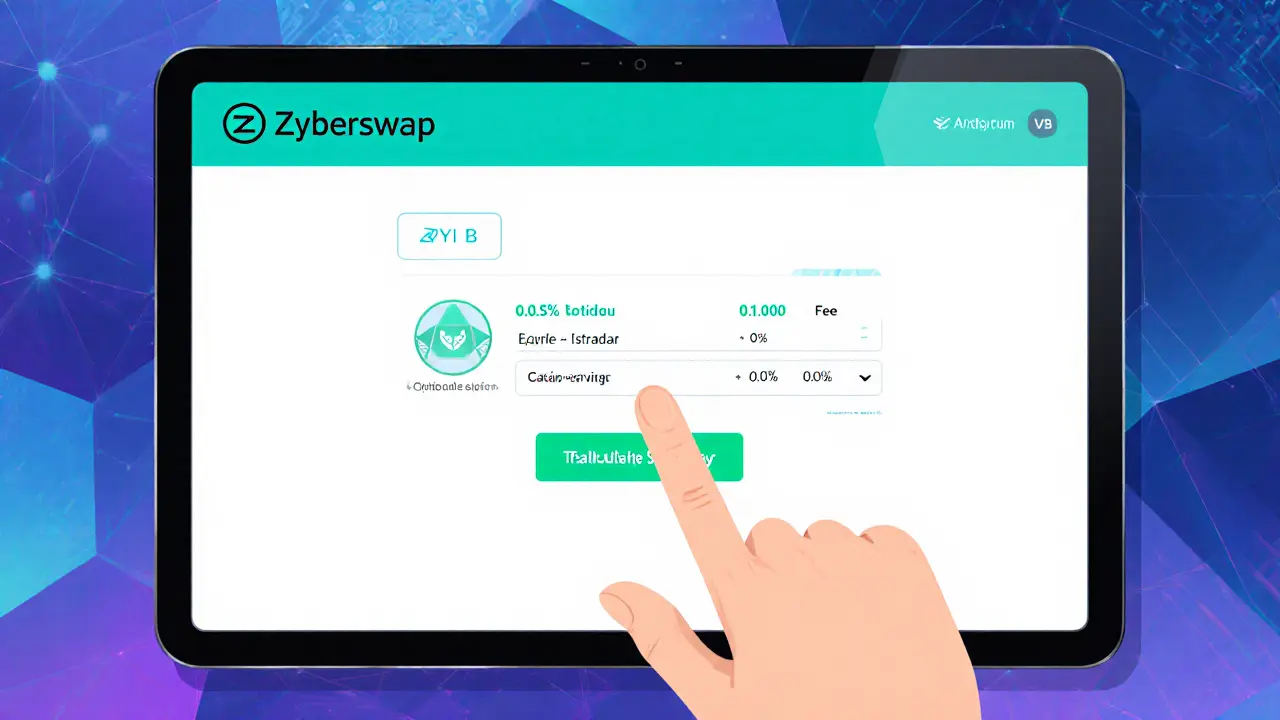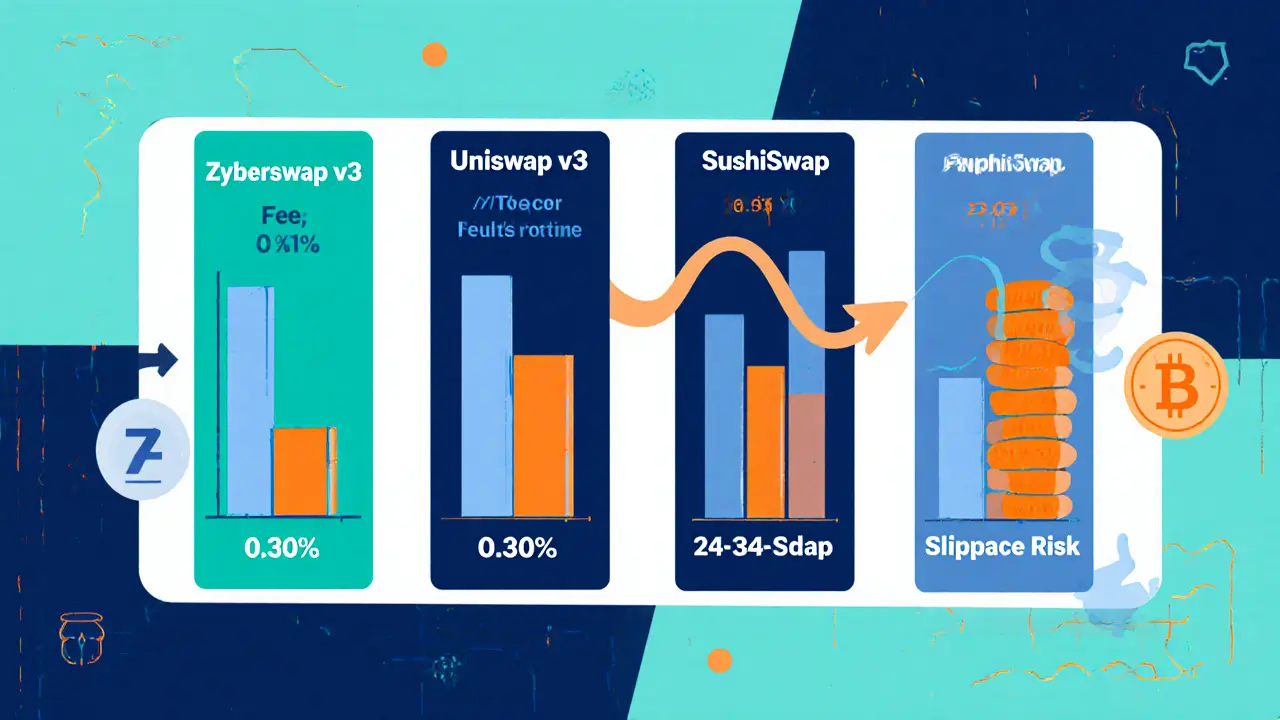Nov 18, 2024, Posted by: Ronan Caverly

Zyberswap v3 Fee Calculator
Estimated Weekly Savings
Zyberswap v3: 0.05% total fee (0.04% + 0.01% protocol fee)
Uniswap v3: 0.30% standard fee
SushiSwap: 0.30% fee
PancakeSwap: 0.25% fee
With Zyberswap v3
Weekly fees: $0.00
Annual fees: $0.00
With Uniswap v3
Weekly fees: $0.00
Annual fees: $0.00
Potential Annual Savings
By switching to Zyberswap v3, you could save approximately $0.00 per year.
Quick Takeaways
- Runs on Arbitrum, offering fast, cheap trades.
- Charges some of the lowest fees in the DEX space.
- Native token ZYB powers staking and governance.
- 24‑hour volume is modest (≈$24K), limiting liquidity.
- Interface is beginner‑friendly, but token pairs are limited.
When you hear the name Zyberswap v3 is a decentralized exchange (DEX) that uses an automated market‑maker (AMM) model on the Arbitrum Layer‑2 chain. It launched as a fair‑launch platform with its own governance token, ZYB, and markets itself as the lowest‑fee DEX for Arbitrum users. Below you’ll get a deep dive into how the platform actually performs, what you get for your money, and whether it’s worth a spot in your trading toolbox.
What Zyberswap v3 Is Built On
The core of Zyberswap v3 is an AMM contract suite that mirrors the logic of early Uniswap versions but is optimized for Arbitrum’s roll‑up technology. Arbitrum processes transactions off‑chain and posts compressed proofs to Ethereum, slashing gas costs dramatically-often under $0.01 per trade. This makes Zyberswap v3 a good fit for traders who want Ethereum‑level security without the exorbitant fees.
Key technical components include:
- Smart contracts that enforce trade execution and liquidity pool rules.
- Liquidity pools that hold pairs of ERC‑20 tokens on Arbitrum.
- A native governance token, ZYB, used for voting on protocol upgrades and for staking rewards.
- Integration with popular Web3 wallets (MetaMask, Trust Wallet, etc.) for seamless connectivity.
Feature Set at a Glance
Beyond the basics of swapping, Zyberswap v3 offers a handful of add‑ons that aim to differentiate it from the crowded DEX landscape:
- Low‑fee model: The protocol claims a base fee of 0.04% (plus a 0.01% protocol fee), which is noticeably lower than Uniswap’s 0.30% standard rate.
- Staking & yield farming: Users can lock ZYB or LP tokens to earn rewards advertised as “among the most lucrative on Arbitrum.” Exact APY numbers vary by pool.
- Community governance: Token‑holder votes decide on fee adjustments, new token listings, and contract upgrades.
- Arbitrum‑native routing: Trades stay on the Layer‑2 network, avoiding cross‑chain bridges that add latency and risk.
Trading Volume and Liquidity
As of the latest snapshot (Oct2024), Zyberswap v3’s 24‑hour trading volume hovered around $24,334 with virtually no BTC‑equivalent activity. By contrast, Uniswap routinely processes $1‑2billion daily. This volume gap translates into thinner order books and higher slippage on larger trades.
Unfortunately, publicly available Total Value Locked (TVL) figures are sparse. The platform’s own UI reports “high liquidity for a variety of cryptocurrencies,” but without concrete numbers it’s hard to benchmark against rivals. For traders moving small amounts (under $5,000), the liquidity is usually sufficient; for institutional‑sized orders, the risk of price impact grows sharply.

Fee Structure Compared to Other DEXs
Here’s a quick rundown of fee tiers across popular DEXs (base fee + protocol fee, where applicable):
- Zyberswap v3: 0.04% + 0.01% = 0.05% total
- Uniswap v3: 0.05%‑0.30% (depends on pool fee tier)
- SushiSwap: 0.30% (0.25% LP fee + 0.05% treasury)
- PancakeSwap (BSC): 0.25% (0.17% LP + 0.08% platform)
If you’re swapping modest amounts, Zyberswap v3’s fee advantage can add up to several dollars per week-a tangible saving for active traders.
Tokenomics and Governance
The ZYB token currently sits around rank #3466 on CoinMarketCap, with a circulating supply of roughly 100million tokens. Distribution was a “fair launch,” meaning no pre‑minted allocation for founders or venture backers. Holders can stake ZYB directly on the platform to earn a share of protocol fees, or they can provide liquidity in ZYB‑paired pools for higher yields.
Governance proposals are submitted through a simple UI and require a quorum of 1% of total supply to pass. Recent proposals have focused on adding new token pairs and tweaking fee parameters, indicating an active, though relatively small, community.
Pros and Cons
Every platform has trade‑offs. Below is a concise list to help you decide if Zyberswap v3 fits your strategy.
- Pros
- Ultra‑low fees ideal for frequent, small‑scale trading.
- Fast, cheap Arbitrum transactions keep costs predictable.
- Simple UI that welcomes newcomers to DeFi.
- Fair‑launch token model aligns with decentralization ethos.
- Cons
- Limited token listings (≈30 pairs) restrict diversification.
- Low daily volume leads to higher slippage on larger orders.
- TVL and liquidity metrics are not transparently disclosed.
- No fiat on‑ramps; you must already hold crypto on Arbitrum.
Getting Started in 5 Steps
- Install a Web3 wallet (MetaMask recommended) and add the Arbitrum network.
- Bridge ETH or USDC from Ethereum to Arbitrum using the official bridge.
- Visit zyberswap.io and click “Connect Wallet.”
- Select your desired token pair, set slippage tolerance (usually 0.5‑1%), and confirm the swap.
- If you hold ZYB, navigate to the “Stake” tab to begin earning protocol fee rewards.
Keep an eye on gas prices during peak network usage; even on Arbitrum, congestion can push fees higher than the quoted 0.01%.
How Zyberswap v3 Stacks Up Against the Big Guys
| Platform | Chain | 24h Volume (USD) | Base Fee | Token Listings | TVL (USD) |
|---|---|---|---|---|---|
| Zyberswap v3 | Arbitrum | 24,334 | 0.04% | ≈30 | ~$2M (estimate) |
| Uniswap v3 | Ethereum L1 | 1.3B | 0.05‑0.30% | ≈5,000 | ~$5B |
| SushiSwap | Multi‑chain | 210M | 0.30% | ≈2,800 | ~$1B |
| PancakeSwap | Binance Smart Chain | 190M | 0.25% | ≈1,500 | ~$800M |
Numbers illustrate why Zyberswap v3 excels on price but lags on depth. If your strategy hinges on tight spreads and low fees, Zyberswap shines. If you need deep order books for large positions, a bigger DEX may be safer.

Frequently Asked Questions
Is Zyberswap v3 safe to use?
The platform runs on audited smart‑contract code and has not suffered any major hacks to date. However, as with any DeFi protocol, there is inherent smart‑contract risk, so only deploy funds you can afford to lose.
Do I need to hold ZYB to trade?
No. ZYB is only required for staking and governance. Swaps can be performed with any ERC‑20 token on Arbitrum.
How do I add a new token pair?
New pairs are added through community proposals. Token holders submit a proposal, and if it reaches quorum, it is voted on. Successful proposals trigger a contract call that creates the liquidity pool.
What gas fees should I expect?
On Arbitrum, typical transaction fees range from $0.001 to $0.01, far lower than Ethereum L1. Peaks can push fees up to $0.03, still cheap compared to mainnet.
Can I withdraw my liquidity at any time?
Yes. Liquidity providers can remove their LP tokens whenever they wish, but they may incur a small withdrawal fee (usually 0.01%). The value returned depends on pool performance and price movement.
Overall, Zyberswap v3 delivers a niche but compelling proposition: ultra‑low fees on a fast Layer‑2 network. Its modest volume and limited token roster keep it from being a one‑stop shop, yet for traders focused on cost‑effective swaps and community governance, it’s worth a look.
Write a comment
Comments
Zack Mast
Ever wonder why we chase lower fees like it's some existential quest? Zyberswap v3 promises 0.05% but the thin liquidity makes every big trade feel like a needle in a haystack. It's a classic case of "cheap today, pricey tomorrow" draped in glossy UI. When the market tides shift, that 0.04% may morph into hidden slippage.
November 18, 2024 AT 07:30
Dale Breithaupt
Zyberswap's fee structure looks good on paper, especially for frequent small swaps. Just keep an eye on slippage when you scale up.
November 22, 2024 AT 20:04
jeffrey najar
Totally, the calculator is handy, but real‑world trades often diverge from the model. I’d run a few test swaps with modest amounts first.
November 27, 2024 AT 08:38
Jonathan Tsilimos
The protocol implements a tiered fee paradigm wherein the base rate of 0.04% is supplemented by a 0.01% protocol levy. Liquidity depth directly influences effective price impact. Consequently, projected savings must be calibrated against depth‑adjusted slippage.
December 1, 2024 AT 21:12
jeffrey najar
Good point on the depth. If you’re moving more than a few hundred dollars, the pool’s $24K daily volume could bite.
December 6, 2024 AT 09:47
Rochelle Gamauf
While the nominal fee differential is alluring, the article neglects to quantify the opportunity cost associated with potential price impact. A rigorous econometric analysis would be requisite to substantiate the claimed savings. Moreover, the absence of real‑time liquidity metrics undermines the practical relevance of the presented figures. Investors should therefore approach the purported 0.25% advantage with circumspection.
December 10, 2024 AT 22:21
Jerry Cassandro
Just plug your numbers into the calculator, but also check the pool’s recent volume on the explorer. That’ll give you a clearer picture of how slippage might affect you.
December 15, 2024 AT 10:55
Parker DeWitt
Sounds too good to be true 🤔. When everyone flocks to the lowest‑fee DEX, the price impact usually spikes, so the “savings” could evaporate faster than you think 🚀.
December 19, 2024 AT 23:30
Allie Smith
yeah, low fees are sweet but the vibe changes when the pool gets shallow. keep an eye on the depth, stay chill.
December 24, 2024 AT 12:04
Lexie Ludens
Oh, the siren song of 0.05%-it beckons the naïve trader like a lighthouse in a storm. Yet beneath the calm surface lurks the abyss of slippage, ready to swallow precious capital. The article glosses over this peril, masquerading it as a footnote. One must not be seduced solely by the fee headline.
December 29, 2024 AT 00:38
Aaron Casey
From a risk‑adjusted perspective, the marginal fee reduction is dwarfed by the variance in execution price caused by shallow liquidity. If you’re allocating capital across multiple protocols, the net effect may be neutral. Consider integrating a slippage buffer into your order parameters.
January 2, 2025 AT 13:12
Leah Whitney
Great advice on setting a slippage buffer. It’s especially vital for larger position sizes.
January 7, 2025 AT 01:47
Lisa Stark
Fee structures in decentralized exchanges have become a competitive battlefield, with platforms like Zyberswap v3 attempting to differentiate themselves through ultra‑low taker fees. The headline figure of 0.05% indeed appears attractive when juxtaposed against the typical 0.30% rates of Uniswap v3 or SushiSwap. However, the economics of liquidity provision dictate that such low fees are sustainable only with sufficient trading volume to compensate liquidity providers. Zyberswap’s reported 24‑hour volume of roughly $24 k suggests a modest depth, which raises concerns about price impact for larger trades. In practice, a trader executing a $10 k swap may encounter slippage that effectively erodes the nominal fee advantage. Moreover, the protocol fee of 0.01% adds a layer of complexity, as it is distributed to token holders, potentially altering the net cost to users. When evaluating the “savings” calculator, one must also consider gas costs, which can be non‑trivial on congested networks. The article’s omission of these ancillary expenses presents an incomplete picture. Additionally, the fee model does not account for the opportunity cost of delayed execution or failed transactions due to insufficient liquidity. From a portfolio management standpoint, the marginal fee reduction should be weighed against the risk of adverse price movement during execution. Historical data from comparable low‑fee pools often show increased volatility in price feeds, which can further diminish realized returns. A prudent approach would involve back‑testing the fee model against real trade data to assess the true net benefit. Users might also consider splitting large orders across multiple DEXes to mitigate slippage while still enjoying lower fees on smaller slices. Finally, community governance and future roadmap developments could impact fee structures, making it essential to stay informed about protocol upgrades. In summary, while Zyberswap v3’s fee architecture is promising, a holistic assessment must include liquidity depth, slippage, gas, and operational risk before declaring it a definitive cost‑saving solution.
January 11, 2025 AT 14:21
Logan Cates
Honestly, these fee calculators are just marketing fluff. Somewhere behind the scenes, there’s probably a hidden token minting scheme. Keep your eyes open.
January 16, 2025 AT 02:55
Shelley Arenson
👍 Looks promising!
January 20, 2025 AT 15:30
Joel Poncz
i get the hype but u should test with small amounts first lol.
January 25, 2025 AT 04:04
Kris Roberts
The pursuit of the cheapest swap mirrors our quest for efficiency in life-always seeking less resistance. Yet, the universe reminds us that less friction often means less stability. Balance is key.
January 29, 2025 AT 16:38
lalit g
I appreciate the detailed breakdown; it helps newcomers evaluate trade‑offs objectively. Respectful discussion enhances community knowledge.
February 3, 2025 AT 05:12
Reid Priddy
While the article praises the low fee, it conveniently sidesteps the fact that reduced fees can lead to thinner order books. A thin book amplifies price impact, which may nullify any nominal savings. One should not accept the narrative at face value.
February 7, 2025 AT 17:47
vincent gaytano
Sure, just ignore slippage and watch your profits vanish.
February 12, 2025 AT 06:21
Shamalama Dee
Remember, the best strategy combines fee awareness with solid risk management. Feel free to ask if you need help setting up safe parameters.
February 16, 2025 AT 18:55
scott bell
What if we ran a simulation swapping $5k across Zyberswap and Uniswap under identical market conditions? The results could reveal hidden costs that the calculator masks. It would be an eye‑opening experiment.

Author
Ronan Caverly
I'm a blockchain analyst and market strategist bridging crypto and equities. I research protocols, decode tokenomics, and track exchange flows to spot risk and opportunity. I invest privately and advise fintech teams on go-to-market and compliance-aware growth. I also publish weekly insights to help retail and funds navigate digital asset cycles.